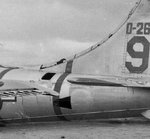Checking over graveyard photos of B-29s I notice that some had an unusual black triangle on the rear fuselage between the rear upper hatch and the tailplane.
On closer inspection is appear to be an exhaust with a black triangular heat/exhaust shield.
Some aircraft have them fitted, but others don't.
I'm wondering it it might have been related to the target towing modification that was made to a number of B-29s.
Have included a photo...any information appreciated
Juanita
On closer inspection is appear to be an exhaust with a black triangular heat/exhaust shield.
Some aircraft have them fitted, but others don't.
I'm wondering it it might have been related to the target towing modification that was made to a number of B-29s.
Have included a photo...any information appreciated
Juanita

